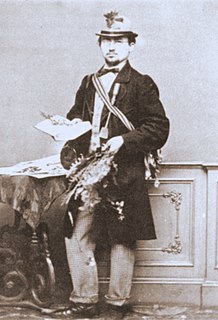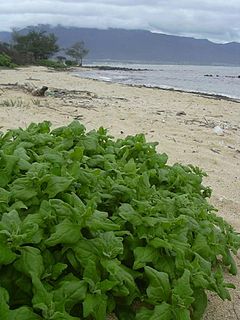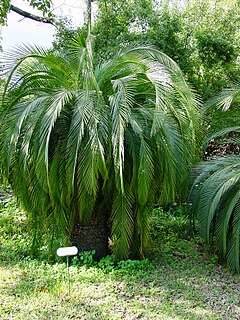| Tetragonia moorei | |
|---|---|
| Scientific classification | |
| Kingdom: | Plantae |
| Clade: | Angiosperms |
| Clade: | Eudicots |
| Order: | Caryophyllales |
| Family: | Aizoaceae |
| Genus: | Tetragonia |
| Species: | T. moorei |
| Binomial name | |
| Tetragonia moorei | |
Tetragonia moorei is a member of the genus Tetragonia and is endemic to Australia.

Australia, officially the Commonwealth of Australia, is a sovereign country comprising the mainland of the Australian continent, the island of Tasmania and numerous smaller islands. It is the largest country in Oceania and the world's sixth-largest country by total area. The neighbouring countries are Papua New Guinea, Indonesia and East Timor to the north; the Solomon Islands and Vanuatu to the north-east; and New Zealand to the south-east. The population of 25 million is highly urbanised and heavily concentrated on the eastern seaboard. Australia's capital is Canberra, and its largest city is Sydney. The country's other major metropolitan areas are Melbourne, Brisbane, Perth and Adelaide.
The annual herb has a prostrate to erect habit that typically grows to a height of 3 to 30 centimetres (1.2 to 11.8 in). It blooms in August producing yellow-green flowers. [1]
The plant has a scattered distribution throughout the Mid West and Goldfields-Esperance regions of Western Australia where it grows in sandy or clay soils. [1]

The Mid West region is one of the nine regions of Western Australia. It is a sparsely populated region extending from the west coast of Western Australia, about 200 kilometres (120 mi) north and south of its administrative centre of Geraldton and inland to 450 kilometres (280 mi) east of Wiluna in the Gibson Desert.

The Goldfields-Esperance region is one of the nine regions of Western Australia. It is located in the south eastern corner of Western Australia, and comprises the local government areas of Coolgardie, Dundas, Esperance, Kalgoorlie-Boulder, Laverton, Leonora, Menzies, Ngaanyatjarraku and Ravensthorpe.
The species was first formally described as Tetragonia tetragonoides by the botanist Kuntze in the work Revisio Generum Plantarum but had been misapplied. M. Gray reclassified it in 1997 in the article A new species of Tetragonia (Aizoaceae) from arid Australia in the journal Telopea . [2]

Carl Ernst Otto Kuntze was a German botanist.
Telopea is a fully open-access, online, peer-reviewed scientific journal that rapidly publishes original research on plant systematics, with broad content that covers Australia and the Asia-Pacific region. The journal was established in 1975 and is published by the National Herbarium of New South Wales, Royal Botanic Gardens & Domain Trust. As from Volume 9, part 1, 2000, full text of papers is available electronically in pdf format. It is named for the genus Telopea, commonly known as waratahs.












